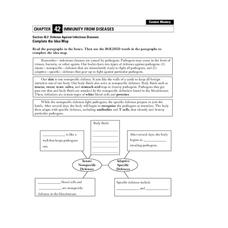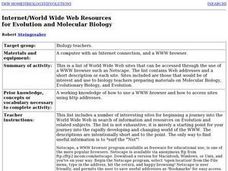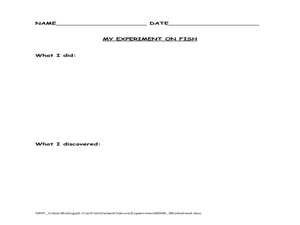Curated OER
The Lynx Eats The Hare
Young scholars investigate the predator and prey relationship. This is done using a simple simulation. The simulation is done as an arts and craft activity. Students record data and track it using a graphic organizer and then they...
Curated OER
Arthropods
For this arthropods worksheet, students will identify 3 different arthropods and compare these organisms' breathing structures: gills, book lungs, and tracheal tubes. This worksheet has 3 fill in the blank and 6 short answer questions.
Curated OER
Defense Against Infectious Diseases
In this infectious diseases activity, students read about the two types of defenses the body has against pathogens: innate (nonspecific) and adaptive (specific). Students then complete a graphic organizer by filling in 11 blanks.
Curated OER
Heredity Worksheet #2
In this genetics worksheet, students use a diagram showing the genetic offspring of plants with different types of seeds to answer 4 short answer questions. Then students determine the traits of offspring of different crosses in 1...
Curated OER
Mitosis and Meiosis Comparison
This t-chart provides a graphic organizer for pupils to list similarities and differences between the two types of cell division. There are no instructions on the handout, so more concrete thinkers may need a little guidance.
Curated OER
Biology Assignment on Sex determination
Students use this activity prior to the introduction of materials on Genetics. They read the article "Becoming a Male, Becoming a Female" in the publication From Egg to Adult. Students then complete the assignment in order to better...
Curated OER
Using an Observation Log to enhance studies in biology
Young scholars choose a subject or setting that be suitable for them to observe for the entire school year. They are encouraged to pick a site that they have ready access to and that they believe be interested in.
Curated OER
Internet/World Wide Web Resources for Evolution and Molecular Biology
Students utilize the Internet and all its web access in this instructional activity. They research all they can on Evolution and related subjects. The journey they begin on leads them into an exhaustible point of possibilities for...
Curated OER
Urban Biology: Can Fish Detect Odors
Learners investigate how fish use their sense of smell. In this scientific method lesson, students design and perform an experiment to investigate how fish use their sense of smell. This lesson includes statistical analysis and...
Curated OER
Honey Bee Biology
Students review the basic parts of an insect and explore the anatomical characteristics of a honey bee. The second part of the lesson focuses on ways to identify a honey bee from other stinging insects.
Curated OER
Biology Research Assignment
Students become aware of and develop an appreciation for science in the world around us.
Curated OER
Adaptation and Mimicry - Biology
Students compare and contrast adaptations involving camouflage, warning coloration, and mimicry. They explain the relationship between adaptation and ability for survival and reproduction. Students define Batesian and Mullerian mimicry...
Curated OER
Bivalve Biology
Young scholars place clams into a beaker containing saltwater. They place a small drop of food coloring just above the shell. Students observe the movement of the food coloring. Clams are then placed into clean beakers of saltwater with...
Curated OER
The Marvels of Mud
Young scientists roll up their sleeves and get a little dirty in this three-day earth science investigation. Following the scientific method, children monitor the growth of algae in pond water samples in order to determine...
Nuffield Foundation
Microbes Ate My Homework
Now you have a new excuse not to do your homework. A long-term experiment has learners explore cellulose-digesting enzymes. They simulate how paper breaks down in a compost bin. There's no need to blame your dog for eating your homework...
Curated OER
Evidence of Evolution by Natural Selection
Walk your junior biologists through the evidence that supports evolution. The fossil record, anatomical record, and molecular record are explained and supported by colorful graphs and pictures. Extensive notes are provided for some of...
Peace Corps
Family
Family traditions are the focus of a lesson that explores the lives of children in India and those in your classroom. Scholars examine their own family roles and traditions, then respond to an informative text detailing a young...
Biology in Motion
Organize-It
Many pupils struggle to categorize and organize related content. Multiple quizzes on a variety of topics offer practice for these specific skills. Scholars move items around until they think each is placed in the proper position....
Curated OER
Catalase: A Bioinformatics Case Study
Students investigate the physical structure of a protein by using a computer simulation tool. They record its primary amino acid structure while viewing it in three dimensions for a better visual recognition. There is also a comparison...
Curated OER
Science Crossword Puzzles: The Ear
Employ this crossword puzzle as a review activity for ear anatomy. Pupils use 8 clues about the anatomy of an ear to solve the puzzle. Answers are not included with this worksheet; however, since there are only 8 words, it should be...
Curated OER
Physiological Adaptations
Students investigate the concepts of genetics and how it is tied to the variations found within different species and how it is tied to adaptations. They review the theory of evolution and factors found to help create variation. The...
Curated OER
Nutritional Relationships Chart
Producers, Herbivores, Carnivores, Decomposers, oh my! Help organize the intricacies between these four types of eaters with this biology worksheet. Scientists display nutritional relationships in a graphic organizer. They place 15 terms...
Curated OER
Bones: Reading and Quiz
Make no bones about it- this anatomy activity is all about the human skeleton! Learners read a 2-page informational excerpt on bones and then use the information they learned to answer 9 recall questions, including 4 multiple-choice and...
Curated OER
Genetically Modified Foods in Perspective
Students research the concept of genetically modified foods. The purpose of the research is to increase science content knowledge and comprehension of the controversy surrounding the subject.























